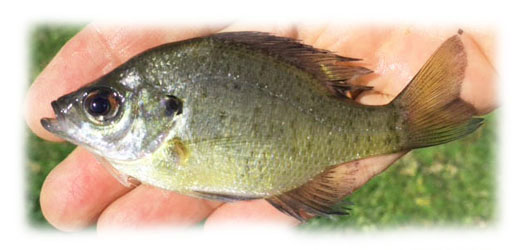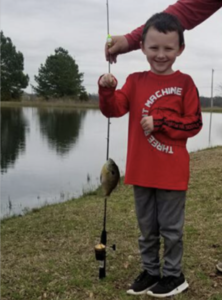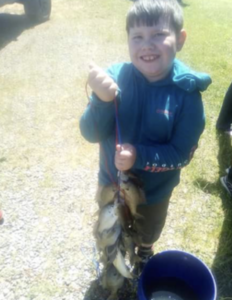
COPPERNOSE and NATIVE BLUEGILL INFORMATION PAGE
Bluegill fingerlings are the food of choice for Bass. Catfish and large Bluegill also like to eat them. They usually spawn/breed well (3 to 5 times a Season) and are rewarding to catch.
One word of advice is to not harvest the largest Bluegill in your pond. Big males will dominate nesting areas, forcing smaller Bluegills to stay away until they reach a size large enough to enter breeding areas. This helps reduce over-population.
If you have to many Bass or Catfish per acre they will reduce your Bluegill population to the point of needing to be re-stocked each year. Establishing a breeding population of Bluegill is a balance that can be struck based on the acres in your pond and the number of fish that you stock and harvest, along with good water quality and safe places for them to spawn, feed and congregate. Stock at a 10 to 1 ratio of 1000 Bluegill to 100 Bass per acre for a first time stocking. You should also stock Fathead Minnows, as they are a favorite support feeder fish for other species.
Bluegill like a wide variety of food. By nature they will feed on smaller fingerlings, insects, worms, plankton and minnows. Correct pond fertilization increases your pond fertility and allows a lot of plankton and microscopic feed for your spawned fry to eat. Without adequate food they begin to starve. To be sure your pond has what they need to thrive – from spawning to adult sizes – you can feed Fish Meal in the shallow areas after spawning and feed 1/8″ fingerling sized feed – floating high protein pelleted food – on a daily basis. From spawned egg to a 2 lb Bluegill can take 5 years in a supplemented feed pond.
Now that pelleted feed has been perfected, Bluegill can reach 2 lbs in size IF they are fed from Springtime through when water temps drop to about 40 degrees in winter. Bluegill will continue to eat until water temps reach 40 degrees, and this is what helps a Bluegill reach 2 lbs in size as quickly as possible.
Native Bluegill are the parent species to Coppernose. They are more cold and heat hardy, but do not grow as fast as Coppernose. Stocking Native as well as Coppernose can strengthen Bluegill genetics in your pond.
Specklebelly Hybrid Sunfish (Bream) are not a good food source for Bass because they do not reproduce in any number. They are stocked for the fun of catching them, and to be able to have Bream in your pond without them taking over. The cross produces the larger mouth of the Sunfish and the aggressiveness of the Bluegill. They grow faster than the standard Bluegill. They do not produce successfully, so plan to restock with them when their numbers get low. See our information on the Specklebelly Hybrid.
Female Bluegill start to spawn after their first year of life. The older the female, the more eggs she produces. A female Bluegill of 4 years may produce 20,000 eggs. Bluegill in a healthy pond can live up to 11 years of age, but typically they live 4-6 years.
If your pond is over-run with Bluegill they can deplete their own food supply chain. If your pond has skinny or short Bluegill, feeding 1/8″ high protein floating pellets (41% protein) will allow them to recover. Whether stunted or heathy, Bluegill will recover and thrive when fed pellets according to instructions. We recommend that you feed floating high protein feed at the same time each day, toward the shallow end. Fingerlings do not like to skyline themselves over predators. You want them to clear up what gets thrown in 10 to 15 minutes each feeding. That way you are not loading up your pond floor with decaying feed, and you can tell how much feed they need to eat for 10-15 minutes as they grown.
Do not use a larger pelleted food for baby fish, as the smaller Bluegill cannot eat them. They need a pellet about 1/3 the size of their mouth. Adults can eat baby sized feed, but baby fish need fingerling sized pellets (about the size of a BB). An adult Bluegill can eat something the size of a pencil eraser at the largest.
Be careful with your pond stocking and fishing. By adding Bass and Catfish to your pond in recommended numbers per acre your Bluegill will not over spawn/hatch and damage their own health. After two summers of healthy feeding you can begin to fish for nice adult-sized Bluegill.
IF YOU SEE DEAD FISH in your pond remove them promptly. Adult Bluegill may suffer from a deadly disease called Bacteria Gill Disease. In Springtime the Bluegill are coming through winter survival and are in a weakened state. Signs of this bacteria are dead or visibly weak Bluegill.
Sick Bluegill will have fuzzy patches of fungus on their sides. They will seek shallow water. To treat your pond add one pound of Copper Sulfate per surface-acre of water. One or two treatments should control the bacteria. If you are not sure how many surface acres you have in your pond, contact us and we may be able to look up your pond on a Satellite Map to calculate it (the Google Earth Pro application), or you can compare your pond to a Football Field. It is approximately one acre in size.


